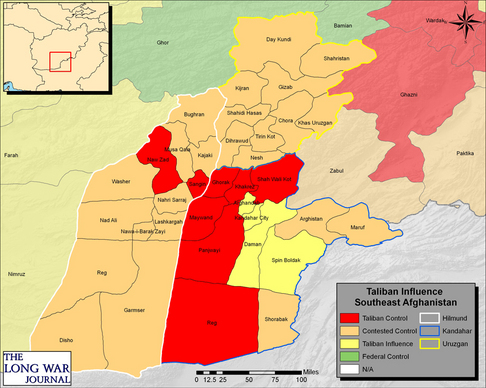|
Click map for full view. Taliban presence, by district, in Kandahar, Uruzgan, and Helmand provinces. Information on Taliban presence obtained from open source and derived by The Long War Journal based on the presence of Taliban shadow governments, levels of fighting, and statements from ISAF commanders. Map created by Bill Raymond for The Long War Journal. |
Coalition forces killed a senior Taliban commander in the insurgency-wracked South, where a battle for control of Kandahar province is underway.
Taliban commander Haji Adam was killed in a “precise air strike” in Kandahar’s contested Maywand district. Adam was “directly involved in the movement of fighters, improvised explosive device production, and in the planning and execution of attacks,” the International Security Assistance Force stated in a press release.
Adam was “also engaged in the illegal narcotics trade in the Sangin area of Helmand, using the profits to fund insurgent activity.” Maywand borders the district of Sangin in neighboring Helmand province. He had “strong links to senior Taliban leaders Akhter Mohammed Mansour, Mullah Naim Barich and Attiqullah.”
The Taliban and Coalition forces have been vying for control of Kandahar’s Maywand province. Several operations have taken place in the rural district over the past year. US soldiers from the 1st Infantry Division’s 3rd Brigade Combat Team built Combat Outpost Terminator earlier this month to establish a permanent presence in the region. Two days prior to the opening of the outpost, two US soldiers and three Afghan civilians were killed in a suicide attack at a market.
Coalition and Afghan forces have been targeting senior Taliban leaders in Kandahar and neighboring Helmand and Uruzgan provinces in an effort to decapitate the group’s leadership and regain control of the rural areas.
In July 2008, several Taliban military commanders and members of the “shadow government” for Kandahar were killed in a series of strikes. The Taliban establishes a shadow or parallel government in the regions it control. These shadow governments fill the void by dispensing sharia justice, mediating tribal and land disputes, collecting taxes, and recruiting, arming, and training fighters.
The Taliban have established shadow governments throughout Afghanistan, with provincial and militarily leaders appointed to command activities. Last week, the Taliban claimed to be in control of more than 70 percent of Afghanistan’s rural areas and established shadow governments in 31 of Afghanistan’s 34 provinces.
In Uruzgan province, Coalition and Afghan forces, lead by the Australians, have conducted multiple operations and raids in an effort to wrest control of the province from the Taliban. Five days ago, Coalition and Afghan forces launched a major operation to clear the Baluchi Valley, a region just south of Tarin Kot.
Over the past year, Australian Special Forces killed four Taliban commanders and captured seven more in Uruzgan. More than 180 Taliban fighters were also killed in the clashes.
In August 2008, Uruzgan’s shadow governor was detained and several Taliban commanders were killed. Heavy fighting took place in October, with more than 70 Taliban killed after they attacked an outpost.
In October, Coalition forces killed a senior Taliban leader who commanded forces in Helmand province and also coordinated operations in Kandahar, Nimroz, and Farah provinces. US Marines killed more than 500 Taliban fighters during operations in Helmand province during 2008. The Marines are expected to be extending the deployment in Helmand as part of the upcoming “surge” of US forces. More than 30,000 US troops are expected to be deployed in Afghanistan by mid-summer.
Kandahar and Helmand provinces remain two of the most violent in Afghanistan. The violence in Uruzgan has tripled during 2008, making it one of the most dangerous provinces in the South.









8 Comments
Bill, I really appreciate your maps. Any chance you could put scale bars on them? It would help us understand the size of the areas and the distances involved.
Glenmore, You are correct, we’ll get that fixed by this evening and re-upload the map.
Thank you for the update Bill.
A buddy of mine is most likely going to Kandahar soon, as part of the “surge”.
So I read with great interest any news from this part of the world.
keep up the great work.
That map is…sobering, to say the least.
The Thunder Run has linked to this post in the blog post From the Front: 01/22/2009 News and Personal dispatches from the front and the home front.
The map, with lots of red in places, looks daunting. Since the Canadians have had success with thier Leo II’s, will the US deploy armor to the flatter terrain around Kandahar? A Stryker Bde, one equipped with the MGS, should be a good fit, unless the US can/wants to go heavier with a heavy BCT. Can you give us some insight Bill? Can anyone? The Talibs are said to run like hell from the Leopards.
Every few months it seems we hear a leader has been killed, yet it’s like removing a flea from a flea infested dog and proudly telling your neighbors you’re one step closer to getting your dog flea-free…
Nice and clear map 🙂 Very good article.